|
|
 |
|

"My thoughts require no reading.
Let the rock that protects them be but a stage for singing
crickets."
--note found at the
Labyrinth
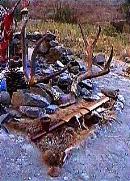 Created
by Helena Mazzariello, a Montclair artist, psychic, and shamanic
practitioner, as "a gift to the world" the Mazzariello Labyrinth,
commonly known as "Mazzariello's Maze," was originally laid out in the
form of a classical labyrinth.
Located in Sibley Volcanic Regional Preserve, in the East Bay
Regional Park District, in the hills above Oakland, California, the
Mazzariello Labyrinth (also dubbed the "Volcanic Witch Project") is in
a remote location, ideally suited as a place of serenity and
contemplation. Those who take the time to trek the extra distance to
reach the site, enter and walk the Labyrinth, pray, meditate, or simply
examine the messages and talismans left in the center are rewarded with
an experience that is profoundly spiritual. A total absence of clergy
and congregation, the sensation is quiet and humble, yet up front and
personal.
For some, the Labyrinth is the catalyst for a true spiritual
awakening. It embodies man's unending religious quest and represents
the frontier of the very limits of our present knowledge of the
mystical world.
Loosely defined under a much broader term: "a circle of stones"
labyrinths have been built since ancient times by almost every religion
in the world for healing and guidance. Being "a circle of stones" a set
of stones ceremonially placed on the ground to magnify spiritual
energy, the Mazzariello Labyrinth takes its rightful place along with
sites such as Stonehenge, in England, and the ancient Medicine Wheels
built by the native American Indians of North and South America.
But
the Mazzariello Labyrinth is unique. Try a web search of the word
“labyrinth” and discover for yourself that no other labyrinth across
the North American continent has anywhere near the untamed, aesthetic
beauty and rugged surroundings of the Mazzariello Labyrinth. Literally
born of volcanic fire and brimstone, the Mazzariello Labyrinth is
positioned at a geologic and spiritual crossroads, where the orient
meets the American west.
The
Mazzariello Labyrinth serves a diverse group of visitors for a range of
purposes. Although no more than several people can be usually found at
the Labyrinth at any given time, the site receives visitors 24 hours a
day, 7 days a week. The Labyrinth plays a small yet essential part in
the lives of many.
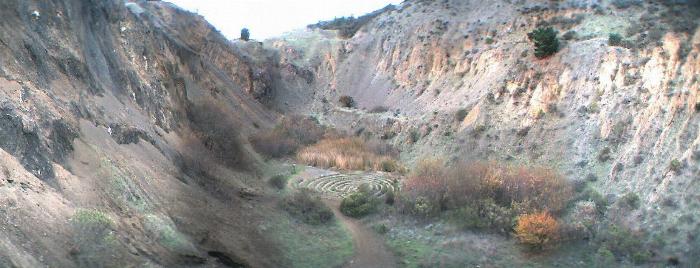
And the Friends of
the Labyrinth desire to keep it that way.
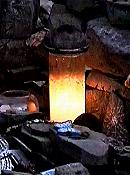
The
purpose for the Friends of the Labyrinth is to help maintain and
preserve a clean, welcome, and quality spiritual experience at the
Labyrinth. While important, this is actually accomplished with a
minimum of effort. But it is a fact of life that good things just
sometimes don’t last, and future situations may require that more
specific efforts and skills come into play from those who truly value
the Labyrinth.
It’s
no secret that the continued existence of the Labyrinth is not a given.
One would do well to recall the fate of another unofficial sacred site,
located behind the Japanese Tea Garden, in Golden
Gate Park, San
Francisco. Similar in many ways to the
Labyrinth, it was a striking assembly of loosely organized rubble with
a central cairn, replete with interfaith offerings and incense.
Slightly
smaller than the Labyrinth, no defined path inside, but the magic was
there. Known and visited by an eclectic assortment of worshippers who
made pilgrimages there from around the world, the site was quietly
dismantled and unceremoniously disposed of by park staffs.
Legality: The
mere presence of the Mazzariello Labyrinth violates laws and codes of
the East Bay Regional Park District. Although warmly embraced by some
park officials, their sanctions of the Labyrinth are unofficial. As a
fairly recent feature to the area, the Labyrinth has not yet passed the
test of time.
Perceived Fire Hazard:
Some homeowners in the region feel that the Labyrinth is a
potential fire hazard, pointing out the candles and incense often found
in the cairn at its center. The Friends of the Labyrinth also feel that
the fire danger conditions at the Labyrinth should be regarded as
extremely high, especially during the dry season that extends from May
to November. But the burning of candles and incense seems to be an
unenforceable feature at any remote site.
Recently,
someone has come up with and implemented a simple, if not elegant,
solution by crafting and placing a rustic, solar powered light that
warms the central cairn with a dim glow in the darkness. Also, the
interior of the central cairn has been rearranged to include a
separate, deep and narrow pit to isolate and contain items that glow or
smolder. Loose candles, matches, lighters and scrap papers found at the
Labyrinth are regularly disposed of by the Friends of the Labyrinth (as
well as park employees) to discourage the casual visitor from
lighting things and simply walking away. As a result, the open burning
of candles and incense at the Labyrinth has dropped off to nil.
Environmental:
Although the Labyrinth is in an abandoned quarry, a totally man made
canyon, nature has re-asserted itself and a seasonal pond has
formed at the Labyrinth's north end. This feature is a unique
biological and ecological site and as such could come under the
jurisdiction of a conservation group or some other environmental
entity. Such a move, while laudable, could ultimately bar public entry
into the tiny watershed of the Labyrinth.
Land
Fill:
The East Bay Municipal Utility District and the East Bay Regional Park
District have recently completed a landfill in a quarried area of the
north end of Sibley Volcanic Regional Park, bordering the Stone
Property. The project was given the expressed mission of
"... recontouring and seeding the project area to create a more
park-like setting" and deposited 100,000 cubic yards of clean fill in
the area.
Likewise,
the Labyrinth could be threatened by a similar project. In 2003, a
hiker fell down a cliff face at the Labyrinth, requireing an
emergency medical litter. Admittedly, parts of the canyon of
the Labyrinth can be steep and dangerous. And this is the age
of the lawsuit. One local municipality is seriously contemplating
the absurd: the removal of all trees from the city's sidewalks,
just to stem the trend of frivilous lawsuits that are causing
massive hemmoraging of the city's coffers.
The
Friends of the Labyrinth affectionately call the abandoned quarry
of the Labyrinth a "canyon." An opportunistic plaintiff
could declare the abandoned quarry of the Labyrinth "an open
mine."
Summary:
In the event any of the above scenarios escalate to a clear and present
level, the Friends of the Labyrinth intend to serve as a grass roots
forum, to collectively remind park officials, and alert the public that
these are public lands, open to all. The East Bay Regional Park
District has been specifically entrusted with the preservation and
maintenance of all natural, as well as cultural, resources within
its boundaries, and managing these public treasures wisely.
Our
existence is known to visitors of the Labyrinth and others via the
internet. The Friends of the Labyrinth, being in communication with
each other, are naturally positioned to actively lobby for the
Labyrinth if it, or public access to the Labyrinth, seems threatened.
Outreach
and Fellowship:
While the main features of the Labyrinth are contemplation and
solitude, it is a fact that small groups of people sometimes do visit
the site. The Friends of the Labyrinth feel that there is a genuine
interest among some visitors to participate in, or simply observe with
fascination, ritual ceremonies and mystical events at the Labyrinth.
Those who already practice rituals at the Labyrinth, now in a very
private way, are considering posting open invitations at this webspace,
to provide an occasional introduction of just some of the wonderful
things that are possible at the Labyrinth.
The
Friends of the Labyrinth have no intentions of “booking up” the
Labyrinth, only to get others to feel a part of it and adopt it as
their own.
YOU
are a Friend of the Labyrinth: It
makes no difference whether you visit the Labyrinth frequently, or only
occasionally, it’s yours if you simply feel that you have a stake in
it. Careful to not succumb to the burdens and trappings of congregation,
the Friends of the Labyrinth have no meetings and rely solely in the
internet for communication, with warm, chance encounters at the
Labyrinth. Consider this webspace as a voice for your thoughts and
feelings about the Labyrinth.
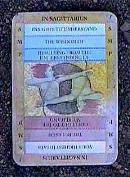
Everything
you always wanted to know about the Labyrinth *
*
But were afraid to ask:
The
Labyrinth is located precisely at:
Longitude: 122 degrees west,
11 minutes, 25 seconds (-122.19043)
Latitude:
37 degrees north, 51 minutes, 11 seconds ( 37.85304)
Okay...
65 feet (20 meters) below Post #4, in the quarry pit, described in the
interpretive trail guide, in Sibley Volcanic Regional Preserve, in the
East Bay Regional Park District, located in the hills above Oakland,
California.
Not quite a ¾ mile, gentle hill-and-dell walk from an easily accessible
trailhead, one will encounter no more than about a 200 foot (61 meters)
change in vertical in getting there. The Labyrinth is about 1,575 feet
(480 meters) above sea level.
From
Post #4, take the short, narrow dirt road that leads south (to your
right, when facing the Labyrinth from above), then loops back north and
down into the quarry pit, ending at the Labyrinth. Avoid scrambling
down any trails directly to the Labyrinth as the slopes at the quarry
(actually a gravel quarry) are steep, unstable and quite dangerous.
It’s not uncommon for visitors to experience at least one minor
landslide at some time during their short visit. It’s just a reminder
of nature reclaiming itself, taking on a more natural, stable
configuration to the landscape.
The
Labyrinth was built, during the spring equinox in 1990, by Helena
Mazzariello (b. c.1960-
), in an area that she routinely took her goats to
graze. She originally layed out the Labyrinth as a
classical (or 7-circuit), left-handed, earthen labyrinth.
But her labyrinth quickly took on a life of its own as
hikers, now attracted to the site, began to build it up as a rock
labyrinth before Helena could finish it.
Labyrinths are
described by how many concentric circuits or paths they contain, and
the first turn in this labyrinth is to the left. Unlike a maze
(and even some labyrinths), a classical
labyrinth has a single, well-defined path that leads to the center with
no dead ends, no loops and no forks. All classical labyrinths share the
basic features of an entrance, a single circuitous path and a center
(aka cairn, altar, eye, fire pit, or shrine).
Some
of the earliest forms of the labyrinth are found in Crete,
dating back to 1500 BC. The legend of Theseus and the Minotaur
generally comes to mind at the mention of the word ‘labyrinth,’ but few
today know and recognize the labyrinth symbol. So important was the
labyrinth in ancient Crete that it was minted
on coins and inscribed on pottery of the time.
An
amazing aspect of the classical labyrinth is that historical variations
of its 7-circuit structure can be found throughout Europe, as well as
the orient, and even pre-columbian North and South America.
An
additional rogue path was later added to the Mazzariello Labyrinth by
someone, obviously on a lark, that extended the original entrance from
the south, around to the now familiar northwest entrance. The Friends
of the Labyrinth feel this addition adds a funky, yet special California
twist to the experience. The Mazzariello Labyrinth was the
first of five labyrinths built throughout the Sibley Volcanic
Regional Preserve and is, by far, the largest and most visited.
Urban
legends persist, of other labyrinths having been built in the
area of present day Sibley Volcanic Regional Preserve, prior to
1990 -and even during the 1930's and
1940's. Unfortunately, thorough studies of high resolution
black and white aerial photo archives of the era only prove a void of
such activities.
| North |

|
| Aerial View
of the Labyrinth |
In
traditional fashion, the Labyrinth was carefully laid out to a
north-south and east-west orientation. Measuring 55 feet (16.76 meters)
across, north to south, and spanning 57 feet 5 inches (17.5 meters),
east to west. Walking the Labyrinth, from the opening to the center and
back out again, one will cover a total distance of 1,352 feet (412
meters). That's the equivalent length of 4 ½ football fields, carefully
laid out in a very small place.
| North |
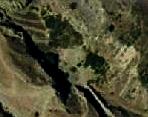
|
| Aerial View
of Labyrinth Canyon |
Due
to its location, at the bottom of a small but steep canyon, the length
of a typical day at the Labyrinth (or the time the sun's direct rays
warm its center) is shortened by about 4 hours, 42 minutes. While not
important to the casual visitor, the actual moment of sunrise and
sunset is crucial in some rituals. It's also a concern to those who
desire to plan a visit that avoids the unpleasant extremes in
temperature that are so common with the summer and winter seasons.
In the summer, actual sunrise
at the Labyrinth, the moment when the sun's rays strike the central
cairn, will be about 2 hours, 9 minutes (more or less) later than the
daily sunrise posted in local weather forecasts.
In the fall and spring,
actual sunrise at the Labyrinth will be about 1 hour, 54
minutes (more or less) later than the daily sunrise posted in local
weather forecasts.
In the winter, actual sunrise
at the Labyrinth will be about 1 hour, 19 minutes (more or less) later
than the daily sunrise posted in local weather forecasts.
The
sun's rays will sweep in from the west, across the floor of the
canyon, toward the central cairn at an average rate (ever slowing)
of 1.24 feet (.38 meters) per minute.

In the summer, actual sunset
at the Labyrinth, the moment when the sun's rays cease to strike the
central cairn, will be about 2 hours, 40 minutes (more or less) before
the daily sunset posted in local weather forecasts.
In the fall and spring, actual sunset
at the Labyrinth, the moment when the sun's rays cease to strike the
central cairn, will be about 3 hours, 9 minutes (more or less) before
the daily sunset posted in local weather forecasts.
In the winter, actual sunset
at the Labyrinth, the moment when the sun's rays cease to strike the
central cairn, will be about 3 hours, 24 minutes (more or less) before
the daily sunset posted in local weather forecasts.
The
shadow of the canyon wall will sweep in from the west, across the floor
of the canyon, toward the central cairn at an average rate (ever
accelerating) of almost 1 foot (.29 meters) per minute.
While
protected from the high winds that frequent the nearby ridges, the
Labyrinth does have a prevailing draft, from the east. The prevailing
wind in the surrounding area is a constant Pacific breeze from the
west. But when it passes over the canyon of the Labyrinth, a highly
localized, low-pressure system is created. The net effect is that the
Pacific winds, from
the west, are pulled down over the Labyrinth, going into a horizontal
roll that gently blows back, to the west, across the
ground level of the Labyrinth.
Heavy fog, rolling in from the Pacific
Ocean,
is a common evening and early morning feature at the Labyrinth, giving
it an eerie, mystical feeling. The fog bank rarely advances much
farther eastward than the Labyrinth and the east bay hills and usually
dissipates by midmorning.
The
Labyrinth experiences about one earthquake a year, 2.8 average
magnitude, originating within a 3.1 mile (5 kilometer) radius
of the Labyrinth, from an average depth of 5 miles (8
kilometers) below the canyon floor.
| Sibley
Volcanic Regional Preserve |
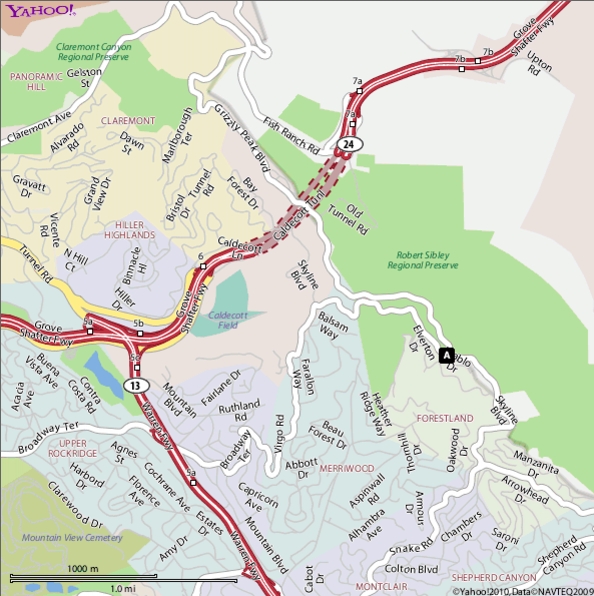
|
| (click
image to view at full size) |
| Sibley
Volcanic Regional Preserve |

|
| (click
anywhere in image to go directly to Sibley Volcanic Regional Preserve's
informative website) |
It’s
not uncommon for Sibley Regional Preserve (as well as other regional
parks) to be temporarily closed due to dry weather conditions that
could cause an extreme fire hazard, putting hikers at risk (it’s
impossible to outrun a western wildfire).
Before
your visit, it’s a good idea to phone the East Bay Regional Park Office
and Trail Closure Hotline for a recorded message as to specific park
closures.
Their
toll-free number is: 1-888-327-2757 Select option 4 on the
voice message menu, and then select option 2 on the submenu, for the
latest info on any trail closures.
Also: East Bay
Regional Park Trail Closure Hotlink: http://www.ebparks.org/closure
|
|

Mountain Lions at
the Labyrinth:
(aka puma,
Felis concolor)
The
Labyrinth is located in mountain lion country, which means that when
you disembark from your car at the trailhead, you become a part of the
food chain. Actually, while mountain lion sightings are not uncommon in
the hills of the East Bay, there has been no record of a
mountain lion ever having attacked a person in the area of the
Labyrinth. But, in 2004, a mountain lion was killed
in the county, for public safety reasons. Mountain lion attacks on
humans are on the increase and the Park District encourages caution
when hiking or biking in open spaces in the East Bay.
Rattlesnakes,
scorpions, and tarantulas are also native to the area of the Labyrinth.
And, like the mountain lion, are just a few of the many realities that
give the Labyrinth a special, tough edge.
Mountain
lions are generally elusive and wary of people, but, like any wildlife,
they can be potentially dangerous. Here are some guidelines in dealing
with the mountain lion threat:
- Do not hike alone. A
mountain lion will usually only stalk solitary people. Go in groups,
with adults supervising children.
Keep children close to you. Mountain lions seem
especially drawn to children. Keep children within your sight at all
times.
Do not approach a
mountain lion. Most mountain lions will try to avoid a
confrontation. Give them a way to escape.
Do
not run from a mountain lion.
A mountain lion can out-sprint a race horse. Running may also
stimulate a mountain lion's instinct to chase. Instead, stand and face
the animal. Make eye contact. If there are small children there, pick
them up if possible so they don't panic and run. Although it may be
awkward, pick them up without bending over or turning away from the
mountain lion.
Do
not crouch or bend over. A
human standing up is just not the right shape for a cat's prey. On the
other hand, a person squatting or bending over looks a lot like a
four-legged prey animal. When in mountain lion country, avoid
squatting, crouching or bending over, even when picking up children.
Appear
larger. Raise
your arms. Open your jacket if you are wearing one. Again, pick up
small children. Throw stones, branches, or whatever you can reach
without crouching or turning your back. Wave your arms slowly and speak
firmly in a loud voice. The idea is to convince the mountain lion that
you are not prey and that you may be a danger to it.
Fight
back if attacked.
Although a 160 pound mountain lion is fully capable of downing an
800 pound elk, many potential victims have fought back
successfully with rocks, sticks, caps, jackets, garden tools and their
bare hands. Since a mountain lion usually tries to bite the head or
neck, try to remain standing and face the attacking animal.
If
you see a mountain lion in a Regional Park, remember the date, time,
location, and exact circumstances. Report it to the Sibley Volcanic
Regional Preserve park office: 1-888-327-2757), select option 3
from the voice menu, and then select extension 4554 to talk
directly to a park staff.
In the case of threatening
behavior, immediately call 9-1-1, or 510-881-1121, from a cell phone,
24 hours a day.
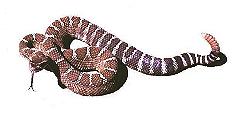
Rattlesnakes
at the Labyrinth:
The Northern Pacific
Rattlesnake
(Crotelus viridis)
Rattlesnakes
are out and about in the area of the Labyrinth, becoming more active as
the weather gets warmer. If you hear a rattlesnake shaking its rattle,
back away. The snake is issuing a warning, and if the warning is
ignored, it may bite. There are many factors (temperature being the
most important) that determine how a snake will react when confronted
by a human. Rattlesnakes should always be observed from a safe distance
and are never safe to handle. Even dead ones can retain some
neurological reflexes, and "road kills" have been known to bite.
Dogs,
too, are occasionally bitten by rattlesnakes, because dogs
are curious by nature and explore with their noses. They tend to run
right up to rattlesnakes, barking and sniffing. So keep your dog under
control at all times.
The
loud buzzing rattler sound coupled with a high rising and very
threatening coil is usually ample identification information for those
in the field. Rattlesnakes have a triangular head that's noticeably
larger than their neck, a thick, non-glossy body, and a blunt tail with
the rattles on the end. When alarmed or threatened, they hiss and
rattle, creating a sound like sizzling bacon. And rattlesnakes simply
look mean-spirited.
Gopher
snakes, a non-venomous (harmless) species also common to the area
of the Labyrinth are, at first glance, quite often confused with
rattlesnakes. But gopher snakes have a head only slightly larger
than their neck. And their bodies are slender and glossy, their tails
are pointed, and they have no rattles. However, when threatened, they
sometimes hiss and thrash their tails around in dry grass and leaves,
creating a rattlesnake-like sound.
Rather
than relying on your skill at differentiating, it's best not to disturb
any snake or for that matter any other wildlife in the regional parks.
Just observe from a distance and enjoy the experience. If you find a
rattlesnake by a picnic table or other developed area, don't attempt to
deal with it yourself. Notify park staff immediately. Park staff
generally do not kill rattlesnakes but relocate them to areas less
visited by humans.
Rattlesnakes
found in the area of the Labyrinth are the Northern Pacific
Rattlesnake, a subspecies of the Western Rattlesnake. These are not
aggressive creatures. They do not initiate attacks, and they certainly
won't chase people down the trails. But they are largely defensive and
tend to stand their ground if provoked.
Rattlesnakes
should be considered armed and dangerous with well-developed
fangs and poison delivery system. A rattlesnake is classified as having
hemotoxic venom that attacks the blood system of its prey. The venom is
a complex mixture of proteins that acts primarily on a victim's blood
tissue. While not as potent as, say, a cobra, the rattlesnake
is far better equipped than a cobra to deliver its venom,
elevating the rattlesnake's status as one of the world's most
dangerous snakes.
Rattlesnakes belong
to a group of snakes known as pit vipers. These dangerous snakes have a
heat-sensitive sensory organ on each side of the head that enables them
to locate warm-blooded prey and strike accurately, even in the dark.
The curved, hollow fangs are normally folded back along the jaw. When a
rattlesnake strikes, the fangs rapidly swing forward and fill with
venom as the mouth opens.
Rattlesnake
young, which have a blunt horny button at the tip of the tail, are
born alive and are equally deadly. They have only one poison fang, but,
unlike the adult rattlesnake, release all of their venom in one strike.
The problem is that rattlesnake young, unlike adult rattlesnakes,
are quite cute and are more likely to be picked up and handled.
Symptoms
of a rattlesnake bite include swelling, pain, weakness, giddiness,
breathing difficulty, hemorrhage, weak pulse, heart failure, nausea,
vomiting, secondary gangrene infection, ecchymosis, paralysis,
unconsciousness, nervousness, and excitability. The bite is extremely
painful, and the toxins in the venom can cause tissue damage.
How To Treat A
Rattlesnake Bite:
- The
best course of action is to keep the snakebite victim still and get
medical care as soon as possible. Cut-and-suck first aid techniques
have long been discredited as doing more harm than good. Cell
phone reception is generally good in the Sibley Volcanic
Regional Park. Simply dial 9-1-1 and inform the emergency dispatcher.
They are trained to lead you through the essential questions and they
may also make an attempt to alert park staff. And, if life
threatening, a determined ambulance driver should be able to force
his way through the gate and negotiate the rough, narrow road
to the Labyrinth. As a secondary measure, notify the regional park
staff, yourself, so that they open gates and also provide
emergency assistance.
- If
you are alone and without a cell phone, and at or near the
Labyrinth, calmly(?) walk directly to the trailhead that is
located at the Sibley Volcanic Regional Park Interpretative Center
(and rest rooms). This route is actually a rough, narrow road and not a
trail, and is one of the more traveled routes in the park, where
you will be more likely to be found by others who can render
assistance. This direct route back will prove especially
important if you become incapacitated or lose consciousness.
- Keep the snakebite victim still, as movement helps the venom
spread through the body.
- Keep the injured body part motionless and just below heart
level.
- Keep the victim warm, calm, and at rest, and transport him or
her immediately to medical care.
- Do not allow the victim to eat or drink anything.
- If
medical care is more than half an hour away, wrap a bandage a few
inches above the bite, keeping it loose enough to enable blood flow
(you should be able to fit a finger beneath it). Do not cut off blood
flow with a tight tourniquet. Leave the bandage in place until reaching
medical care.
- If
you have a snakebite kit, wash the bite, and place the kit's suction
device over the bite. (Do not suck the poison out with your mouth.) Do
not remove the suction device until you reach a medical facility.
Venomous
snakebites are rare, and they are rarely fatal to humans. Of the 8,000
snakebite victims in the United States each year, only about 10 to 15
die... but don't forget that 8,000 people are bitten each year.
A
final word of reassurance. Visitors to the regional parks are very
seldom bitten by rattlesnakes. And in virtually every snakebite case,
the victim was attempting to pick up, harass, or in some way handle the
creature.
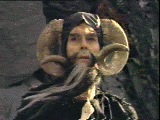
Regarding
rituals at the Labyrinth and the law:
We feel
it necessary to include this information because a simple (but
authentic) ritual at the Labyrinth can easily rack up a considerable
number of charges, or at least a good scolding, against the hapless
visitor. Read on.
Federal
and State Law:
All birds of prey are federally protected. It is a violation of federal
law to have eagle, hawk, owl, and falcon claws, or even a feather of
such in your possession without express permission from the federal
government. Legal possession of these items is only granted
to certain American Indians for use in ritual ceremony, and museums for
public display. If you have illegal possession of such, you are
encouraged, by law, to contact the appropriate authorities and/or
return them to the land with reverence and gratitude.
Now,
the Friends of the Labyrinth (and even most park rangers) know that
illegal talons, feathers, etc used in clandestine rituals are more than
likely the result of road kill. And one may argue that it would be a
crime of conscience to allow such a magnificent bird to simply become a
grease spot in the asphalt. But that doesn't change things. But take
heart in the fact that the numerous hawks and owls (and occasional
eagle sightings) found in the vicinity of the Labyrinth are living
testimony of the success of this uncompromising attitude.
The
fact remains that most of us don't have a legal "right" to possess
these items. Do as you must, but be discreet. Read on.
The Sibley
Volcanic Regional Preserve: The
Park District's Ordinance 38, as it pertains to possible Labyrinth
activities, is summarized below. Violators will be subject to citation
or arrest. Park visitors are responsible for knowing and following
rules. For further information, ask a Park Ranger, Volunteer Trail
Patrol member, or contact the Sibley Volcanic Regional Preserve park
office.
-
Ceremonial pyrotechnics and fireworks are not permitted at
the Labyrinth, or in any regional park.
-
Fires
(and flames) are not permitted at the Labyrinth. It is also illegal to
place hot coals on the ground. Being a fire critical area, smoking
(incense, ceremonial peace pipes, calumets, etc) is also illegal. Do as
you must, but be careful and discreet.
-
It
is illegal to disturb, collect, or impede in the movements of natural
creatures within District parklands. For example, gently picking up a
snake found in a chance encounter and incorporating it in a primitive
or spiritual ritual, then returning it, unharmed, back to the place it
was found is a violation park rules. It may also soften the edge of
that creature's sharp instinct for survival.
-
A park curfew is in effect between the hours of 10:00pm and 5:00am, unless a permit is obtained to remain on
parklands. The trailhead parking lot is subject to closure 6:00pm, November through March. Again,
do as you must, but be discreet.
-
Assemblies, performances, special events or similar
gatherings require a permit. Use your discretion here.
- Gathering
of flowers, ferns, berries, and other plants found at the Sibley
Volcanic Regional Preserve is prohibited. If you intend to place
flowers in the central cairn of the Labyrinth, you are encouraged to
bring your own domestic grown flora.
-
Overnight camping is not permitted within District parklands
without a permit.
-
Beer and wine are permitted at the Labyrinth. But use
discretion.
-
Bows and arrows are not permitted on regional parklands
except at established ranges.
-
Spears, swords, crossbows and other dangerous weapons
are prohibited anywhere on regional parklands.
-
A permit is required for amplification of voice, music, or
other sounds.

|
|
|
 |

